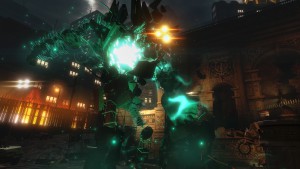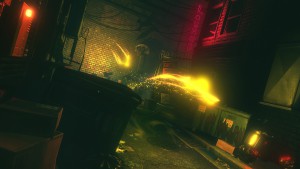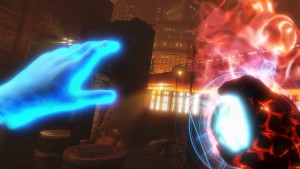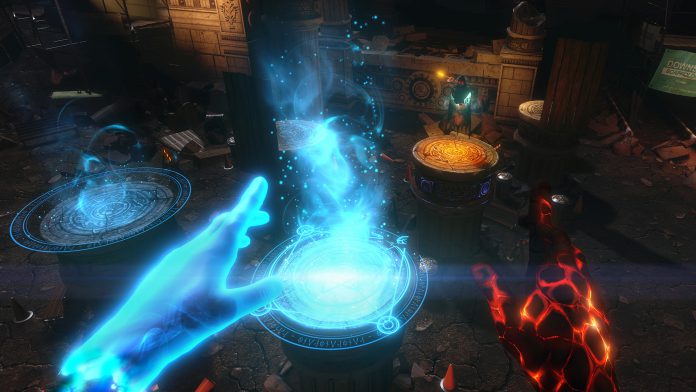Yesterday saw the release of two virtual reality (VR) exclusive titles to join Insomniac Games’ Edge of Nowhere, and The Unspoken was announced alongside Feral Rites, both differing from each other in genre, design, and gameplay.
VRFocus spoke to Chad Dezern, the Studio Director and Creative Director of The Unspoken as well as Insomniac’s renewed title, Ratchet and Clank. Dezern touches on what the video game is all about, how the Oculus Touch immerses the player, and about the choices of camera positioning.
VRFocus: Could you explain what the The Unspoken is all about and its features?
Chad Dezern (CD): The Unspoken taps into a fantasy of magic in the real world. It’s a VR first-person action game that’s focused on PVP spell casting. So in this game you use the Oculus Touch controller to cast spells, and we’re really out to get players casting spells with their bare hands. In a skill-based way with a lot of nuance and gestre, perfecting the art of spell casting.

For the back story in The Unspoken you fall into a hidden world of ancient cabal and organised crime, and you duel powerful magicians to rise through the ranks and rule the city street by street. At first you learn parlour tricks, you learn the basics, but to progress you learn to summon golems, and eventually your powers manifest themselves in blinding fireworks displays of arcane energy. Magic in The Unspoken is about harnessing the unseen forces of the city itself, and manipulating objects in the world around you.
It’s very much of the Urban Magic genre, your entry point is an urban magician’s fight club, and you fight in concealed locations across the city of Chicago – these are like little pocket dimensions. You find yourself in a war of vampire controlled alleys in Pulaski Park, you find yourself on a hidden rooftop garden at the Gold Coast, and you find the great buildings of the 1893 World’s Fair perfectly preserved beneath the Chicago stockyards.

These fights are like PVP turf wars. We think of this game as marrying the physical action of a fighting game to the dynamic battlefield of an arena shooter, so skilful spellcasting is a part of it. You can really get better at casting spells as you discover what you can do – but also understanding your environment as part of the game. There are cover points, strategic high ground. You teleport through the space and it’s really good to be mindful of the entire 360 degree battlefield in VR. Every single duel is like a dance – it’s a back and forth of fast pace attack and avoidance spellcasting, and matches culminate in the environment around you crashing down.
One really important thing to know is when facing off against another human and you can see that person’s tracked head and hands, if you’ve ever experienced tracked head and hands in VR you know that you can really see all of the little gestures that make a human being a human. So it ends up with this real feeling of presence like you’re really interacting with another person in the room that you’re casting spells.
So the summary is that The Unspoken is about casting spells with touch, it’s about emersing yourself into a magic fight club, and it’s about duelling your way through PVP turf wars in a secret Chicago that pulls you in and doesn’t let go.

It’s exclusive to the Oculus storefront for Oculus Touch and it’s arriving Holiday 2016.
VRFocus: How did you utilise the Oculus Touch to make sure gameplay was fully immersive?
CD: Our goal is for players to not even think about the fact that there ae controllers in their hands but rather the hands in the game and what their hands are doing in the real world, and to that end we build spells around a set of gestures such as tracing a line, grabbing swiping, without any buttons at play. This is a very button-light game.

The touch-controllers have some very nicely situated buttons on the index fingers and in the palm that end up being really natural to use in the way that you’re thinking about the shape of your hand and not the controller.
VRFocus: How did you use camera techniques to tackle motion sickness in this first-person title?
CD: In the game your major traversal mechanic is teleportation and that is more of a style choice as it works well in the game that’s about magicians’ duels, it’s part of a fantasy of feeling like you’re a magician. It also does play into making sure we have a comfortable scheme for players, so every time you teleport there’s a one second fade-out and that’s to make sure players aren’t getting disorientated and you can get your bearings. And as it turns out those things worked really well with gameplay because that little cool-down makes sure you’re not simply moving around in a way that’s impossible for the other player to track.















